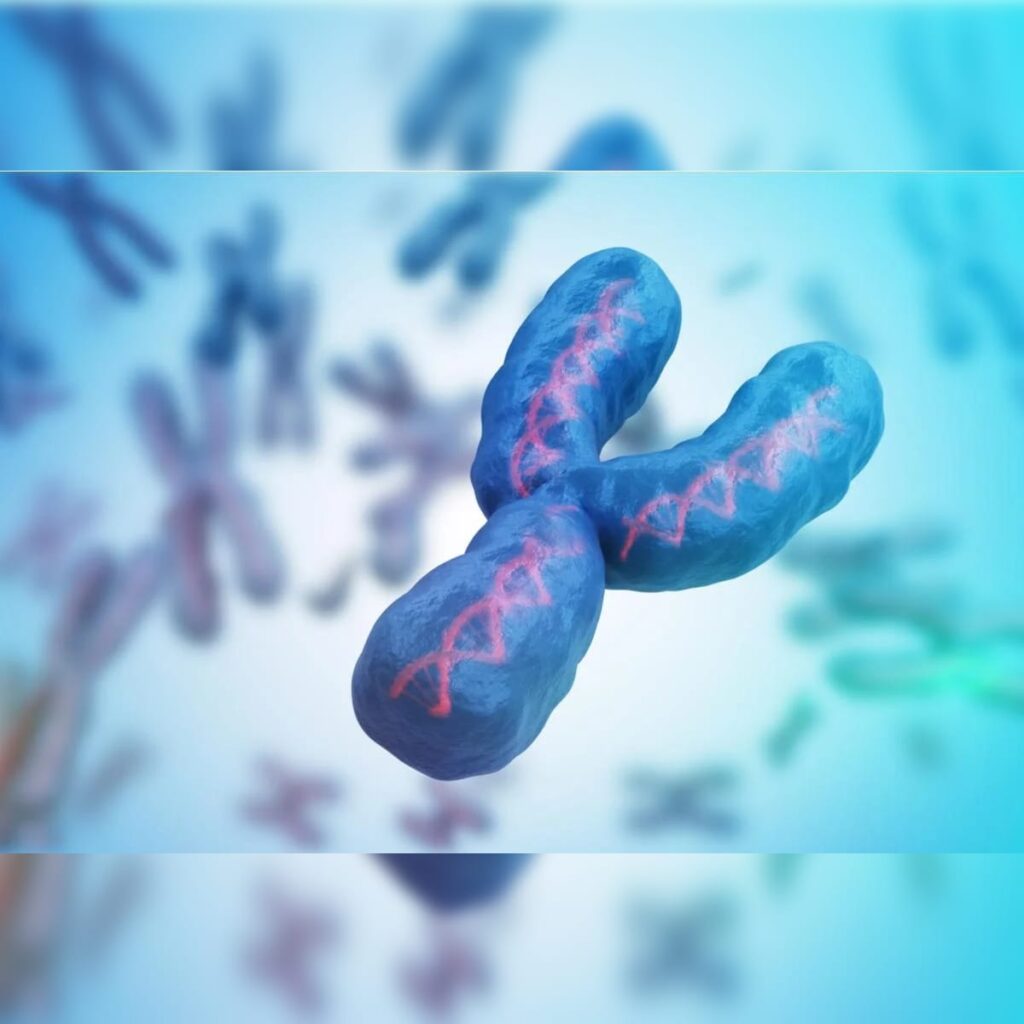The Y chromosome, which plays an important role in determining male biological features, has been under intensive scientific investigation due to its progressive reduction over millions of years. The Y chromosome, formerly a strong genetic structure, has lost a substantial amount of its genes, prompting experts to worry about its extinction. Current projections indicate that if this tendency continues, the Y chromosome will disappear within the next 11 million years. This scenario raises exciting issues about the future of human reproduction, as well as the evolutionary adaptations that may emerge in the face of such severe genetic alterations. As we explore the ramifications of a diminishing Y gene, we find not just the issues it brings, but also life’s extraordinary resilience & adaptation.

What is the Y chromosome?
The Y gene, specifically the SRY (Sex-determining Region Y) gene, is extremely important in human biology. It is the key determinant of male sex and stimulates the formation of male reproductive organs throughout embryonic development. The presence of the Y chromosome, especially the SRY gene, initiates a series of genetic processes that result in the creation of testes, and the generation of male hormones like testosterone. This process is critical for determining masculine traits and reproductive capability.
Key Functions of the Y Gene:
Sex Determination: The SRY gene is necessary for male sex determination. It stimulates other genes, such as SOX9, which are required for testis development and impact male differentiation in vertebrates.
Fertility: The Y chromosome carries genes necessary for spermatogenesis, which ensures healthy sperm production and male fertility.
Health Implications: Beyond its role in reproduction, current research suggests that genes on the Y chromosome may impact a variety of health consequences. Certain Y-linked genes have been associated with immunological responses, cardiovascular health, and illness risk, including cancer and Alzheimer’s disease.

The Y chromosome has experienced major evolutionary changes over millions of years, resulting in a severe drop in gene content—it has lost around 900 genes since its creation. Currently, it has around 55 functioning genes. This degradation raises worries about the Y chromosome’s long-term survival; some experts believe that if current trends continue, the Y chromosome may vanish totally within the next 11 million years. The Y gene is more than just a marker of male differentiation; it performs a variety of roles in health and sickness. Understanding its activities and evolutionary history is critical for comprehending the larger implications for human biology and potential future changes in sex-determination processes. As research reveals the complexity of the Y chromosome, it contradicts long-held beliefs that it is a genetic wasteland, emphasizing its importance in both reproduction and overall health.
The disappearance of the Y gene is a complex phenomenon driven by several evolutionary and genetic factors.
Key Factors which contribute to the Disappearance of the Y Gene:
Genetic Degeneration: The Y chromosome has suffered considerable degeneration over millions of years, losing around 97% of its original genes. This loss is due to a lack of recombination, which inhibits the Y chromosome from successfully eliminating harmful mutations while retaining advantageous ones. As a result, detrimental alleles may accumulate, leading to a decrease in general genetic health.
High Mutation Rates: The Y chromosome’s environment, notably the oxidative conditions in the testes, exposes it to increased mutation rates during sperm generation. Each cell cycle during gametogenesis raises the possibility of mutation, increasing genetic harm across generations.
Inefficient Natural Selection: The Y chromosome’s inability to fuse with another chromosome during meiosis reduces its vulnerability to natural selection. This inefficiency enables harmful alleles to “hitch-hike” with favorable ones, accelerating genetic decay. Due to its unique inheritance pattern (passing solely through men), the Y chromosome has a smaller effective population size than autosomal chromosomes, rendering it more vulnerable to genetic drift and loss.
Methylation and Gene Silencing: As people age, genes on the Y chromosome can become hyper methylated, resulting in silence and loss of functioning without full chromosomal loss. This mechanism can contribute to reduced expression of Y-linked genes and has been implicated in several health concerns, including cancer and cardiovascular disease.
Evolutionary Pressures: The Y chromosome’s evolutionary history includes periods of high selection pressure, which drove specialization and subsequent degeneration. In certain species, alternate sex determination systems have developed in response to comparable constraints, indicating that while the Y gene encounters problems, it may also adapt in unexpected ways.
The absence of the Y gene is more than just a question of genetic loss; it reflects larger evolutionary dynamics such as mutation rates, natural selection inefficiencies, and aging processes. Understanding these characteristics is critical for determining the long-term consequences for male fertility and health as this trend continues.

Economic Impact of The Disappearance of the Y Chromosome
The potential disappearance of the Y chromosome may have significant economic implications, particularly as it relates to demographic changes and societal structures. Here are some key considerations:
Economic Impact of a Declining Y Chromosome:
Demographic Shifts: If the Y chromosome disappears, male births may become increasingly infrequent. This demographic transition may result in a largely female population, altering employment dynamics and economic output. A major decline in the male population might have an impact on businesses that have traditionally been dominated by males, such as construction and some industrial sectors.
Workforce Composition: As the gender balance alters, there may be more focus on female participation in certain industries. This might result in more investment in women-focused businesses, thereby changing job markets and economic objectives. Companies may need to adjust their employment procedures and workplace regulations to reflect a changing demographic environment.
Social Structures and Economic Development: There are historical similarities to the Neolithic period when a bottleneck in male genetic variation corresponded with the growth of agriculture and economic prosperity. The concentration of wealth among a few strong persons during the period resulted in social hierarchies that affected economic systems. A similar dynamic might arise if there are fewer male births, perhaps leading to new social structures and economic models that favor female leadership and entrepreneurship.
Innovation and Adaptation: The emergence of novel sex-determining mechanisms in animals such as spiny rats implies that humans may adapt similarly. This flexibility might drive innovation in reproductive technology and genetic research, resulting in new sectors centered on fertility treatments and genetic engineering. Such breakthroughs might have a significant economic impact, creating jobs and boosting expansion in the biotechnology sector.
Potential for New Species: If various populations evolve their sex-determining mechanisms, multiple human species may emerge throughout time. This split may result in socioeconomic differences due to divergent reproductive tactics or social norms, impacting global trade, migration patterns, and international relations.

Is there a solution?
To address the potential disappearance of the Y chromosome and its associated implications, several strategies can be considered. These approaches aim to preserve the integrity of the Y chromosome, enhance our understanding of its functions, and explore innovative reproductive technologies.
Strategies to Mitigate Y Chromosome Degeneration:
Gene Conversion Research:
Understanding Mechanisms: Research into gene conversion pathways on the Y chromosome might shed light on how it maintains genetic integrity. By understanding the mechanisms that allow the Y chromosome to “recombine” with itself via palindrome sequences, scientists may create strategies to boost these natural processes, thereby slowing down degeneration.
Genetic Engineering: Advances in genetic engineering may enable the introduction of beneficial genes or alterations that improve the Y chromosome’s stability and functionality
Enhanced Genetic Mapping:
Detailed Mapping of Y Chromosome Genes: Further efforts to map the Y chromosome more accurately can aid in the identification of essential genes and their roles. This knowledge might be used to develop tailored medicines or interventions that preserve important genetic functioning.
Identifying Deletion Intervals: By determining whether specific parts of the Y chromosome are susceptible to deletion or mutation, researchers may focus on protecting these portions through genetic treatments.
Reproductive Technologies:
Assisted Reproductive Technologies (ART): Innovations in ART, such as sperm sorting or preimplantation genetic diagnosis (PGD), can assist guarantee that male embryos are chosen for implantation, therefore maintaining a balanced sex ratio.
Gene Therapy: Future breakthroughs may enable gene therapy procedures that can fix or replace faulty genes on the Y chromosome, improving male fertility and general health.
Public Awareness and Education:
Raising Awareness: Educating the public about the value of genetic variety and the significance of the Y chromosome can help to build support for research efforts focused on understanding and protecting it.
Promoting Healthy Lifestyles: Encouraging healthy lifestyles that limit environmental conditions that cause genetic mutations may help offset some of the hazards associated with Y chromosome degeneration.
Longitudinal Studies:
Monitoring Changes Over Time: Conducting long-term studies on populations to monitor changes in Y chromosome structure and function can provide valuable data that inform future interventions and policies.
Health Implications Research: Investigating how changes in the Y chromosome correlate with health outcomes can lead to early detection methods for diseases linked to Y-linked genes, such as certain cancers.
Conclusion
The probable removal of the Y chromosome poses a multidimensional dilemma with far-reaching consequences for human reproduction, health, and societal institutions. As we traverse this difficult topic, it is critical to understand the role of the Y gene in male sex determination and overall genetic variation. The continuing deterioration of the Y chromosome, caused by causes like as genetic mutation, recombination failure, and evolutionary pressures, needs a proactive strategy.
By investing in research that improves our understanding of the Y chromosome’s activities and processes, we may look into novel options like improved reproductive technology and gene therapy. Public awareness and education will also play an important role in increasing support for these efforts.
While the implications of a decreasing Y chromosome may look remote, tackling this issue now, can better prepare us for future demographic upheavals and economic disruptions. Finally, knowing and maintaining the Y chromosome is more than simply genetics; it is an important step towards assuring humanity’s resilience and adaptation in an ever-changing planet.
Written by Vihaan Kulkarni
Edited by




